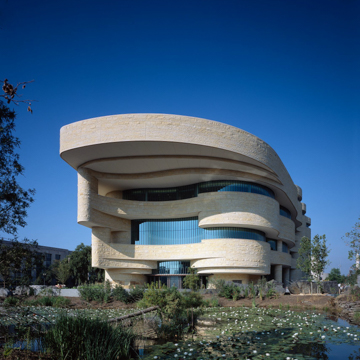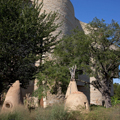The National Museum of the American Indian is situated on the National Mall at the corner of Independence Avenue and 4th Street in Southwest Washington, facing the United States Capitol. The Museum was founded in 1989 by the passing of the National Museum of the American Indian Act, after the discovery that the Smithsonian Institution held more than 12,000 to 18,000 Indian remains, largely in storage. The new institution's museum was first located in the former Museum of the American Indian in New York City, established in 1916, which became part of the Smithonian in 1989. However, the expanding collections and increasing national importance necessitated a permanent location on the National Mall.
The Museum's siting on the National Mall is significant, particularly the building's confrontational engagement with the Capitol building, a form of acknowledgment and contempt for federally supported genocides of Native peoples throughout the nation's history. Prior to the design of the structure, the Museum engaged in a three-year dialogue with Native communities in the United States, Canada, and Mexico to develop a guiding document, "The Way of the People," which shaped the design of the building. The guide suggested ways to address and incorporate Native sensibilities, including the importance of nature and spirituality. The effort was to create an institution that would educate the general public about Native American traditions and cultures and also provide ceremonial space and accommodation for scholars and visiting Native Americans. One of the most important goals was to highlight that Native communities were not restricted to their anthropological pasts, but instead were alive and active.
The museum hired a collaborative group of Native American architects—Douglas Cardinal (Blackfoot), Johnpaul Jones (Cherokee/Choctaw), Donna House (Dine/Oneida), and Ramona Sakiestewa (Hopi)—to design a building that contrasted neighboring cultural institutions. Most obviously, the building does not follow the modernist and classical forms of the other Smithsonian museums. Even in orientation, the National Museum of the American Indian incorporates Native customs by facing east toward the rising sun. Architecturally, the building’s distinctive curvilinear form evokes a wind-sculpted rock formation not unlike those of the Medicine Rocks in Montana. The five-story structure is clad in golden-toned Kasota stone, a dolomitic limestone from Minnesota.
The shape of the museum was also significantly determined by the 4.25-acre trapezoidal site. The grounds were considered to be an extension of the building and a critical part of the museum as a whole. Indeed, the natural environment aims to highlight the rich landscapes of the Americas, with more than 27,000 trees, shrubs, and herbaceous plants of 145 species to represent the natural Chesapeake Bay environment that existed prior to European contact. In particular, forests were historically important for Native practices of shelter, food, and medicine. The museum’s croplands also incorporate the irrigation and planting techniques of Native peoples that revolutionized agriculture around the world. In addition to greenery, the designers integrated Native traditions, for example positioning forty large uncarved rocks and boulders—Grandfather Rocks—on the grounds to welcome visitors to the museum and serve as reminders of the Native people’s relationship to the environment. Four other stones were brought from Native communities of the Northwest Territories, Canada (north); Isla Navarino, Chile (south); Great Falls, Maryland (east); and Hawaii (west).
On the interior, the museum is organized around a central soaring dome that represents a central gathering and ceremonial space; it features a special prism to allow light to enter. The galleries are largely isolated from the rest of the outside world to allow for greater flexibility and to protect the light-sensitive artifacts. The interior experience is characterized by the curvilinear traffic pattern dictated by walls and halls. Exhibitions detail the long history and diversity of Native American communities as well as their complex and nuanced contemporary identities.
Since its opening, the museum has been burdened with several controversies about the collections, ownership and control, building and exhibition design. Many of these disagreements emerge from the challenge of integrating so many Native cultures and histories into one institutional organization.
References
Lonetree, Amy, and Amanda J. Cobb. The National Museum of the American Indian: Critical Conversations. Lincoln: University of Nebraska Press, 2008.
Krakauer, John. “A New Vision for a Museum on the Mall.” Smithsonian Magazine, May 1996.
Smithsonian Institution Office of Design and Construction. "The Way of the People: National Museum of the American Indian." Master Facilities Programming. Revised Draft Report. November 1991. Unpublished.



















